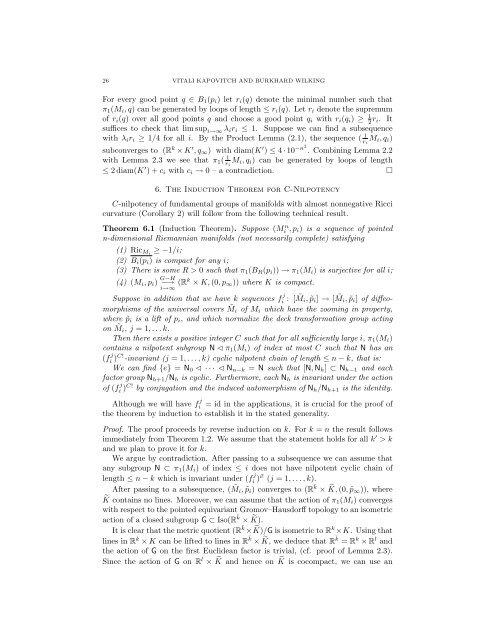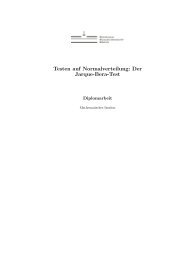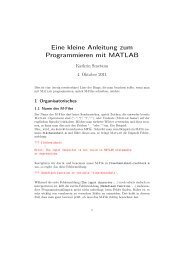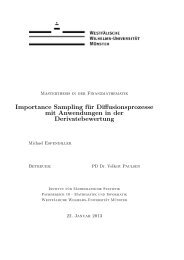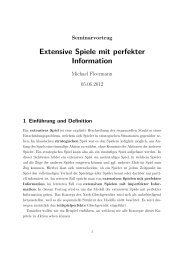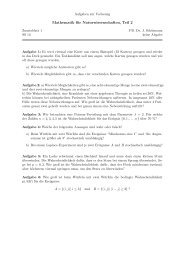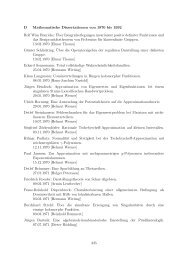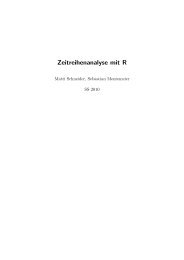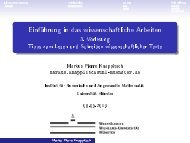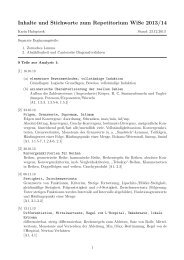Margulis Lemma
Margulis Lemma
Margulis Lemma
You also want an ePaper? Increase the reach of your titles
YUMPU automatically turns print PDFs into web optimized ePapers that Google loves.
26 VITALI KAPOVITCH AND BURKHARD WILKING<br />
For every good point q ∈ B 1 (p i ) let r i (q) denote the minimal number such that<br />
π 1 (M i , q) can be generated by loops of length ≤ r i (q). Let r i denote the supremum<br />
of r i (q) over all good points q and choose a good point q i with r i (q i ) ≥ 1 2 r i. It<br />
suffices to check that lim sup i→∞ λ i r i ≤ 1. Suppose we can find a subsequence<br />
with λ i r i ≥ 1/4 for all i. By the Product <strong>Lemma</strong> (2.1), the sequence ( 1 r i<br />
M i , q i )<br />
subconverges to (R k × K ′ , q ∞ ) with diam(K ′ ) ≤ 4 · 10 −n2 . Combining <strong>Lemma</strong> 2.2<br />
with <strong>Lemma</strong> 2.3 we see that π 1 ( 1 r i<br />
M i , q i ) can be generated by loops of length<br />
≤ 2 diam(K ′ ) + c i with c i → 0 – a contradiction.<br />
□<br />
6. The Induction Theorem for C-Nilpotency<br />
C-nilpotency of fundamental groups of manifolds with almost nonnegative Ricci<br />
curvature (Corollary 2) will follow from the following technical result.<br />
Theorem 6.1 (Induction Theorem). Suppose (M n i , p i) is a sequence of pointed<br />
n-dimensional Riemannian manifolds (not necessarily complete) satisfying<br />
(1) Ric Mi ≥ −1/i;<br />
(2) B i (p i ) is compact for any i;<br />
(3) There is some R > 0 such that π 1 (B R (p i )) → π 1 (M i ) is surjective for all i;<br />
(4) (M i , p i ) G−H<br />
−→<br />
i→∞ (Rk × K, (0, p ∞ )) where K is compact.<br />
Suppose in addition that we have k sequences f j i : [ ˜M i , ˜p i ] → [ ˜M i , ˜p i ] of diffeomorphisms<br />
of the universal covers ˜M i of M i which have the zooming in property,<br />
where ˜p i is a lift of p i , and which normalize the deck transformation group acting<br />
on ˜M i , j = 1, . . . k.<br />
Then there exists a positive integer C such that for all sufficiently large i, π 1 (M i )<br />
contains a nilpotent subgroup N ⊳ π 1 (M i ) of index at most C such that N has an<br />
(f j i )C! -invariant (j = 1, . . . , k) cyclic nilpotent chain of length ≤ n − k, that is:<br />
We can find {e} = N 0 ⊳ · · · ⊳ N n−k = N such that [N, N h ] ⊂ N h−1 and each<br />
factor group N h+1 /N h is cyclic. Furthermore, each N h is invariant under the action<br />
of (f j i )C! by conjugation and the induced automorphism of N h /N h+1 is the identity.<br />
Although we will have f j i = id in the applications, it is crucial for the proof of<br />
the theorem by induction to establish it in the stated generality.<br />
Proof. The proof proceeds by reverse induction on k. For k = n the result follows<br />
immediately from Theorem 1.2. We assume that the statement holds for all k ′ > k<br />
and we plan to prove it for k.<br />
We argue by contradiction. After passing to a subsequence we can assume that<br />
any subgroup N ⊂ π 1 (M i ) of index ≤ i does not have nilpotent cyclic chain of<br />
length ≤ n − k which is invariant under (f j i )i! (j = 1, . . . , k).<br />
After passing to a subsequence, ( ˜M i , ˜p i ) converges to (R¯k × ˜K, (0, ˜p ∞ )), where<br />
˜K contains no lines. Moreover, we can assume that the action of π 1 (M i ) converges<br />
with respect to the pointed equivariant Gromov–Hausdorff topology to an isometric<br />
action of a closed subgroup G ⊂ Iso(R¯k × ˜K).<br />
It is clear that the metric quotient (R¯k × ˜K)/G is isometric to R k ×K. Using that<br />
lines in R k × K can be lifted to lines in R¯k × ˜K, we deduce that R¯k = R k × R l and<br />
the action of G on the first Euclidean factor is trivial, (cf. proof of <strong>Lemma</strong> 2.3).<br />
Since the action of G on R l × ˜K and hence on ˜K is cocompact, we can use an


